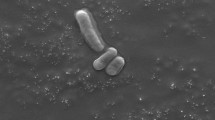Abstract
A cryptic plasmid pL2 was isolated from Lactococcus lactis subsp. lactis and its complete nucleotide sequence was determined (5,299 bp, GenBank accession No. DQ917780). Its replication mode was identified as a theta-type belonging to the pAMβ1 family. Analysis of the nucleotide sequence revealed that pL2 contained a transfer origin, a replication origin, and five putative open reading frames (ORF1-5). ORF1 (386 amino acids) was homologous to replication protein RepB. The other open reading frames were cryptic. A small counter-transcript RNA (ctRNA) coding region was also observed.




Similar content being viewed by others
References
Aleshin VV, Semenova EV, Doroshenko VG, Jomantas YV, Tarakanov BV, Livshits VA (1999) The broad-host-range plasmid pLF1311 from Lactobacillus fermentum VKM13411. FEMS Microbiol Lett 178:47–53
Alpert CA, Crutz-Le Coq AM, Malleret C, Zagorec M (2003) Characterization of a theta-type plasmid from Lactobacillus sakei: a potential basis for low-copy-number vectors in lactobacilli. Appl Environ Microbiol 69:5574–5584
Anderson DG, McKay LL (1983) Simple and rapid method for isolating large plasmid DNA from lactic streptococci. Appl Environ Microbiol 46:549–552
Emond E, Lavallee R, Drolet G, Moineau S, Lapointe G (2001) Molecular characterization of a theta replication plasmid and its use for development of a two-component food-grade cloning system for Lactococcus lactis. Appl Environ Microbiol 67:1700–1709
Gravesen A, Josephsen J, von Wright A, Vogensen FK (1995) Characterization of the replicon from the lactococcal theta-replicating plasmid pJW563. Plasmid 34:105–118
Hanahan D (1985) Techniques for transformation of E. coli. In: Glover DM (ed) DNA cloning, vol 1. IRL Press, Oxford, pp 109–136
Hayes F, Vos P, Fitzgerald GF, de Vos WM, Daly C (1991) Molecular organization of the minimal replicon of the novel, narrow-host-range, lactococcal plasmid pCI305. Plasmid 25:16–26
Kanatani K, Tahara T, Oshimura M, Sano K, Umezawa C (1995) Identification of the replication region of Lactobacillus acidophilus plasmid pLA103. FEMS Microbiol Lett 133:127–130
Kok J, Leenhout KJ, Haandrilman AJ, Ledeboer AM, Venema G (1988) Nucleotide sequence of the cell wall proteinase gene of streptococcus cremoris Wg2. Appl Environ Microbiol 54:231–238
van Kranenburg R, de Vos WM (1998) Characterization of multiple regions involved in replication and mobilization of plasmid pNZ4000 coding for exopolysaccharide production in Lactococcus lactis. J Bacteriol 180:5285–5290
Lucey M, Daly C, Fitzgerald G (1993) Identification and sequence analysis of the replication region of the phage resistance plasmid pCI528 from Lactococcus lactis subsp. cremoris UC503. FEMS Microbiol Lett 110:249–256
Raha AR, Hooi WY, Mariana NS, Radu S, Varma NRS, Yusoff KY (2006) DNA sequence analysis of a small cryptic plasmid from lactococcus lactis subsp. lactis M14. Plasmid 56:53–61
Reed K, Mann DA (1985) Rapid transfer of DNA from agarose gels to nylon membranes. Nucleic Acids Res 13:7207–7221
Sambrook J, Fritsch EF, Maniatis T (1989) Molecular cloning: a laboratory manual, 2nd edn. Cold Spring Harbor Laboratory, Cold Spring Harbor, NY
Seegers JFML, Bron S, Francke CM, Venema G, Kiewiet R (1994) The majority of lactococcal plasmids carry a highly related replicon. Microbiology 140:1291–1300
Seegers JFM, van Sinderen D, Fitzgerald GF (2000) Molecular characterization of the lactococcal plasmid pCIS3: natural stacking of specifity subunits of a type I restriction/modification system in a single lactococcal strain. Microbiology 146:435–443
Wilson GW (1993) Restriction and modification systems. Annu Rev Genet 25:585–627
von Wright A, Raty K (1993) The nucleotide sequence for the replication region of pSV40, a lactococcal food grade cloning vector. Lett Appl Microbiol 17:25–28
Yan TR, Wang MR, Chen CH (1998) A facile PCR method for detecting replication mode of lactococcial plasmids. Biotechnol Tech 12:85–89
Acknowledgments
This work was supported by grants NSC 90-2214-E-036-005 and NSC 91-2214-E-036-001 from the National Science Council, Republic of China.
Author information
Authors and Affiliations
Corresponding author
Rights and permissions
About this article
Cite this article
Chang, SM., Yan, TR. DNA sequence analysis of a cryptic plasmid pL2 from Lactococcus lactis subsp. lactis . Biotechnol Lett 29, 1519–1527 (2007). https://doi.org/10.1007/s10529-007-9418-2
Received:
Revised:
Accepted:
Published:
Issue Date:
DOI: https://doi.org/10.1007/s10529-007-9418-2




